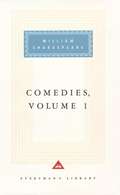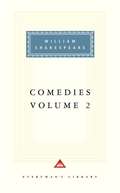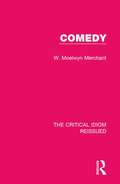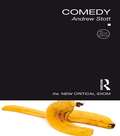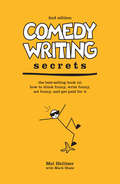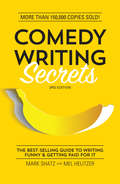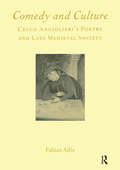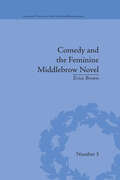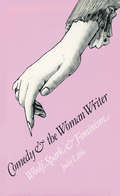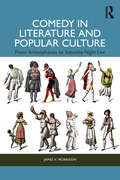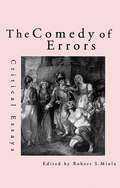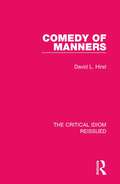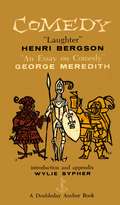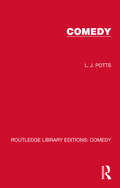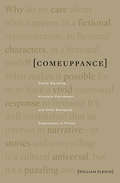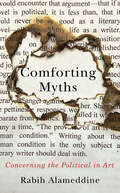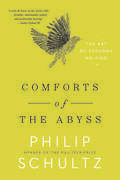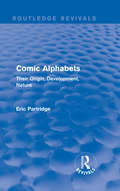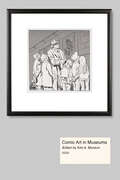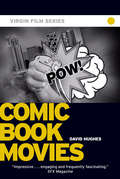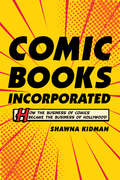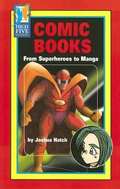- Table View
- List View
Come scrivere un romanzo d'amore - Guida per principianti per scriverlo e pubblicarlo
by Susan Palmquist Maria De BonisHai mai sognato di scrivere un romanzo d’amore? In questa seconda edizione di “Come scrivere un romanzo d’amore”, imparerai suggerimenti e trucchi per cominciare a scrivere la tua storia, completarla e proporla a un editore o agente. Imparerai: -Come inventare idee per delle storie -Come pianificare il tuo romanzo -L’importanza dei primi tre capitoli -Come creare il conflitto -Come aumentare l’emozione nella storia -Come creare personaggi e dialoghi che affascinano il lettore -Come creare la tensione sessuale -Come preparare una proposta che si faccia notare -Luoghi dove proporre le tue storie -Suggerimenti di scrittura per trovare l’ispirazione Se hai mai voluto imparare il mestiere dello scrittore ma non hai mai avuto il tempo o il budget necessario per frequentare un seminario, questo libro ti offre tutto ciò di cui hai bisogno per cominciare.
Comedies
by William ShakespeareShakespeare forged his tremendous art in the crucible of his comic imagination, which throughout his life enveloped and contained his tragic one. His early comedies, with their baroque poetic exuberance, intense theatricality, explosive bursts of humor, and superbly concrete realizations of the dialects of love, capture as in a chrysalis all that he was to become. They provide a complete inventory of the mind of our greatest writer in the middle of his golden youth. This volume contains The Comedy of Errors, The Taming of the Shrew, The Two Gentlemen of Verona, Love's Labor's Lost, A Midsummer Night's Dream, and its companion piece, Romeo and Juliet, which Tony Tanner describes in his introduction as "a tragedy by less than one minute." The texts, authoritatively edited by Sylvan Barnet, are supplemented with textual notes, bibliographies, a detailed chronology of Shakespeare's life and times, and a substantial introduction in which Tanner discusses each play individually and in the context of Shakespeare's oeuvre.
Comedies, Volume 2
by William ShakespeareShakespeare's later comedies were written at the astonishing pace of about two plays a year. In them, he moves beyond the farce of his earlier comedies to richer and more varied dramas. These range from the famous "problem plays," which blend humor with tragedy, to the idyllic romances set in such timeless locales as the Forest of Arden. They contain some of his wittiest and most memorable characters, from cross-dressing heroines, bantering lovers, and wisecracking fools to the villainous but sympathetic Shylock and the boisterous and bawdy Falstaff. This volume contains The Merchant of Venice, The Merry Wives of Windsor, Much Ado About Nothing, As You Like It, Twelfth Night, All's Well That Ends Well, and Measure for Measure. The authoritatively edited text of the plays is supplemented with footnotes, bibliographies, a detailed chronology of Shakespeare's life and times, and a substantial introduction in which Tony Tanner discusses each play individually and in the context of Shakespeare's work.
Comedy (The Critical Idiom Reissued #20)
by Moelwyn MerchantFirst published in 1972, this work pursues the question ‘what is comedy?’ In its quest for an answer it explores critical theory, psychology, sociology and metaphysics. It also examines the classical origins of comedy, different kinds of comedy, the rituals of comedy, its relationship with other idioms such as ‘satire’, irony’ and ‘farce’, and compares two major traditions: ‘Aristophanic’ and ‘Shakesperean’ comedy. In doing so, the book demonstrates the indefinable and flexible nature of comedy. This work will be a valuable resource to those studying drama, and in particular, those focusing on classical and Shakespearean plays.
Comedy (The New Critical Idiom)
by Andrew StottThis new edition of Andrew Stott’s Comedy builds on themes presented in the first edition such as focusing on the significance of comic 'events' through study of various theoretical methodologies, including deconstruction, psychoanalysis and gender theory, and provides case studies of a number of themes, ranging from the drag act to the simplicity of slipping on a banana skin. This new edition features: updates to reflect new research the field new chapters on Women in Comedy and Race and Ethnicity a broader range of literary and cultural examples. Written in a clear and accessible style, this book is ideal introduction to comedy for students studying literature and culture.
Comedy Writing Secrets
by Mel Helitzer Mark ShatzThe Only Handbook for Humor Writers! "What is comedy? Comedy is the art of making people laugh without making them puke."-Steve Martin Become the funniest person in the room! With Comedy Writing Secrets, 2nd edition, you can master the fundamentals of humor writing and turn your comedic talent into a well-paying pursuit. For more than a decade, Comedy Writing Secrets has been giving aspiring comedians a leg up on the competition. In this expanded new edition, Mel Helitzer, named the "funniest professor in the country" by Rolling Stone magazine, and funnyman Mark Shatz pack in even more insight and instruction, including: Humor writing exercises to punch up your jokes. Extra information on writing for sitcoms and stand-up. Comedic brainstorming techniques using associations and listings. Exclusive tips for writing humor for specific markets like editorials, columns, speeches, advertising, greeting cards, t-shirts, and more. Tap into your comedic genius with Comedy Writing Secrets, 2nd edition, and you'll always leave 'em laughing!
Comedy Writing Secrets: The Best-Selling Guide to Writing Funny and Getting Paid for It
by Mel Helitzer Mark ShatzThe Only Handbook for Humor Writers! "What is comedy? Comedy is the art of making people laugh without making them puke."-Steve Martin Become the funniest person in the room! With Comedy Writing Secrets, 2nd edition, you can master the fundamentals of humor writing and turn your comedic talent into a well-paying pursuit. For more than a decade, Comedy Writing Secrets has been giving aspiring comedians a leg up on the competition. In this expanded new edition, Mel Helitzer, named the "funniest professor in the country" by Rolling Stone magazine, and funnyman Mark Shatz pack in even more insight and instruction, including: Humor writing exercises to punch up your jokes Extra information on writing for sitcoms and stand-up Comedic brainstorming techniques using associations and listings Exclusive tips for writing humor for specific markets like editorials, columns, speeches, advertising, greeting cards, t-shirts, and more Tap into your comedic genius with Comedy Writing Secrets, 2nd edition, and you'll always leave 'em laughing!
Comedy and Culture: Cecco Angiolieri's Poetry and Late Medieval Society (Italian Perspectives Ser. #Vol. 8)
by Fabian Alfie"This work examines the ways in which the culture and society of the Middle Ages impacted on the works of the Sienese poet, Cecco Angiolieri (c.1260-1312). It analyzes how Angiolieri's poetry conformed to medieval notions and practices of comicality. The study explores the means by which Cecco satirized important cultural movements of the late 13th and early 14th centuries, such as love literature and the ascendant Franciscan order. In addition, it looks at his relations with other writers of the day, including three insulting sonnets addressed to Dante Alighieri. The text shows that Angiolieri was not an isolated, ""bizarre"" figure, as some early 20th century scholars have described him, but rather an author in step with his times."
Comedy and the Feminine Middlebrow Novel: Elizabeth von Arnim and Elizabeth Taylor (Literary Texts and the Popular Marketplace #3)
by Erica BrownElizabeth von Arnim and Elizabeth Taylor wrote witty and entertaining novels about the domestic lives of middle-class women. Widely read and enjoyed, their work was often dismissed as middlebrow. Brown argues their skilful use of comedy and irony provided the receptive reader with subversive commentary on the cruelties and disappointments of life.
Comedy and the Woman Writer: Woolf, Spark, and Feminism
by Judy LittleRecent critics have affirmed the difficulty—perhaps the impossibility—of defining modern comedy; at the same time, some feminist scholars are seeking to understand the special comedy often present in literature written by women. Comedy and the Woman Writer responds to both these concerns of recent criticism: feminist literary theory and theories of comedy. Judy Little develops a critical apparatus for identifying feminist comedy in recent fiction, especially the radical political and psychological implications of this comedy, and then applies and tests her theory by examining the novels of Virginia Woolf and Muriel Spark. Despite recent scholarly attention to Woolf, the profound comedy of her work has been largely overlooked, and the comic fiction of Spark has seldom had the responsible and attentive criticism that it deserves. The introductory chapter draws upon anthropology and sociology, as well as literary criticism and the fiction of feminist writers such as Woolf, Doris Lessing, and Monique Wittig, to define a modern feminist comedy. Four central chapters then explore the implications of this comedy in the novels of Woolf and Spark. Little distinguishes between, on the one hand, several varieties of traditional comedy and satire and, on the other, the festive or “liminal” comedy to which feminist comedy belongs. Both Woolf and Spark mock centuries-old mythic patterns and behaviors deriving from basic social norms, as well as the values emerging from these norms. It is one thing, the author points out, to find “manners” amusing, to scourge vices, or to mock the follies of lovers; it is a much more drastic act of the imagination to mock the very norms against which comedy has traditionally judged vices, follies, and eccentricities. While the comedy of Woolf and Spark has some precedent in festive or liminal celebrations, during which even basic values and behavior are abandoned, feminist comedy displays its radical nature by implying that there is no resolution to the inverted overturned world, the world in revolutionary transition.The final chapter considers briefly, in the light of the critical model of feminist comedy, the work of several other twentieth-century writers, including Jean Rhys, Penelope Moritmer, and Margaret Drabble. The presence of radical comedy in the fiction of these and other writers suggests the need for continuing attention to the theory of feminist comedy proposed in this study.
Comedy in Literature and Popular Culture: From Aristophanes to Saturday Night Live
by James V. MorrisonComedy in Literature and Popular Culture: From Aristophanes to Saturday Night Live explores works of comedy from the past 2,500 years.James V. Morrison discusses works including those of Aristophanes and Plautus, Shakespeare and Moliere, and modern comic writers, performers, and cartoonists, such as Thomas Nast, P. G. Wodehouse, Charlie Chaplin, and Jerry Seinfeld, asking the following questions: Is comedy a mirror of our lives? Is it “funny ’cuz it’s true?” Or is it funny because it ignores reality? Should we distinguish between the plot of a comic play and the jokes found in it? Are the jokes just there to make us laugh or are the jokes as essential as the plot? Do memories of satirical portrayals on the comic stage displace recollections of the historical person? By juxtaposing works from different cultures and time periods, the book demonstrates a universal recourse to certain familiar techniques, situations, and characters.This vibrant study offers a compelling analysis of comedy as a mode, form, and genre. It is an engaging read for students and scholars of comparative literature, literary history, media studies, and theater and performance.
Comedy of Errors: Critical Essays (Shakespeare Criticism Ser.)
by Robert S. MiolaThis collection of essays and reviews represents the most significant and comprehensive writing on Shakespeare's The Comedy of Errors .This volume of critical essays also features a comprehensive critical history, a full bibliography, and photographs and reviews of major productions of the play around the world.
Comedy of Manners (The Critical Idiom Reissued #36)
by David L. HirstFirst published in 1979, this book traces comedy of manners from the 1660s to the then present — a scope beyond the traditional focus on the Restoration and early twentieth century. It uncovers an underestimated subversive potential and socially critical force in this particularly English dramatic form, emphasising the distinctive subjects and style that distinguish it from more general forms of witty social satire. The author discusses the major comic dramatists of the post-Restoration period; reassesses the significance of Sheridan, Wilde and Coward; and examines the continuation of the tradition in modern writers. This book will be of interest to students of English literature and drama.
Comedy: An Essay on Comedy
by George Meredith Henri Bergson Wylie SypherWhen she has frolicked through her five Acts to surprise you with the information that Mr. Aimwell is converted by a sudden death in the world outside the scenes into Lord Aimwell, and can marry the lady in the light of day, it is to the credit of her vivacious nature that she does not anticipate your calling her Farce.
Comedy: The European Heritage (Routledge Library Editions: Comedy)
by L. J. PottsOriginally published in 1949 this book is a study of comedy based on representative works of drama and narrative, mainly in English, from Chaucer to Bernard Shaw. The theme is that comedy implies a philosophy of life that is fairly constant, despite the changes in social conditions and fashions of thought. There is a bibliographical index and the book is illustrated fully and widely by quotations from English comic writers.
Comeuppance: Costly Signaling, Altruistic Punishment, and Other Biological Components of Fiction
by William FleschWith Comeuppance, William Flesch delivers the freshest, most generous thinking about the novel since Walter Benjamin wrote on the storyteller and Wayne C. Booth on the rhetoric of fiction. In clear and engaging prose, Flesch integrates evolutionary psychology into literary studies, creating a new theory of fiction in which form and content flawlessly intermesh. Fiction, Flesch contends, gives us our most powerful way of making sense of the social world. Comeuppance begins with an exploration of the appeal of gossip and ends with an account of how we can think about characters and care about them as much as about persons we know to be real. We praise a storyteller who contrives a happy or at least an appropriate ending, and fault the writer who refuses us one. Flesch uses Darwinian theory to show how fiction satisfies our desire to see the good vindicated and the wicked get their comeuppance. He conveys the danger and excitement of reading fiction with nimble intelligence and provides wide reference to stories both familiar and little known. Flesch has given us a book that is sure to claim a central place in the discussion of literature and the humanities.
Comfort and Domestic Space in Modern Spain (Toronto Iberic #91)
by Susan LarsonComfort and domestic space are complex narratives that can help draw our attention to everything from urban planning, everyday objects, and new technologies to class conflict, racial and ethnic segregation, and the gendering of domestic labour. Comfort and Domestic Space in Modern Spain delves into the history of ideas surrounding the modern home. It explores how the collective experience of domestic space has been shaped by government ideologues, technocrats, and artists as well as working- and middle-class Spaniards since the late nineteenth century. The book focuses on the social and cultural meanings of domestic space in ways that invite us to cross boundaries between private and public, the particular and the general, the local and the global, and to pay attention to the role of the cultural imagination in making a house into a home. Considering a wide variety of voices and perspectives that have resulted in new ideas about how to inhabit domestic space, Comfort and Domestic Space in Modern Spain brings together an international, interdisciplinary group of scholars to illuminate the cultural history of everyday life.
Comforting Myths: Concerning the Political in Art (Kapnick Foundation Distinguished Writer-in-Residence Lectures)
by Rabih AlameddineA timely and urgent inquiry by one of global literature's leading lights In this concisely argued and illuminating book, the PEN/Faulkner Award–winning author Rabih Alameddine takes the subject of politics and art head-on, questioning the very premise of dividing these two pillars of culture into an either/or proposition. He reveals how a political dimension enlarges a work of art rather than making it less beautiful or reducing it to a polemic, as we are so often and carelessly taught. But he also ponders what makes art political to begin with: how essential is the artist&’s conscious political intent, and what does the reader or viewer contribute to the work&’s political capability or significance? In exploring these questions, Alameddine engages intensely with his role as an immigrant and a gay author writing inside a globally dominant, often oblivious culture, and invokes the work of numerous writers, from Tayeb Salih and Aleksandar Hemon to Teju Cole and Salman Rushdie, who also struggle to be heard as something more than an &“other.&” The book features throughout Alameddine&’s brilliantly relatable voice—shrewd, humorous, challenging, and as honest about his own limitations as he is about his passions.
Comforts of the Abyss: The Art Of Persona Writing
by Philip SchultzA vivid, intimate, and inspiring exploration of how to write through persona, from the Pulitzer Prize–winning founder of an influential writing school. Throughout his growth as a writer, acclaimed poet Philip Schultz has battled with the dark voice in his head—the “shitbird,” as his late friend the poet Ralph Dickey termed it—that whispers his insecurities and questions his ability to create. Persona writing, a method of borrowing the voice and temperament of accomplished writers, offers him imaginative distance and perspective on his own negative inclinations. In this candid and generous book, Schultz reflects on his early life in an immigrant neighborhood of upstate New York, his first writing experiments inspired by Ernest Hemingway and John Keats, his struggles with dyslexia, and the failures he witnessed in his father’s life and his own. Through surprising, sometimes humorous, and encouraging encounters with the writers who influence him—including Elizabeth Bishop, Joan Didion, and Norman Mailer—as well as moving experiences of loss, Schultz learns how to fashion personas out of pain. Perceptive, enlightening, and profound, Comforts of the Abyss reveals how persona writing can be used as a tool for unlocking a writer’s own story, the philosophy on which Schultz founded The Writers Studio in 1987.
Comic Alphabets: Their Origin, Development, Nature (Routledge Revivals: The Selected Works of Eric Partridge)
by Eric PartridgeFirst published in 1961, this book explores the form of the comic alphabet. Whether through poems, prose or phonetics, the alphabet has become a way in which mankind has taken pleasure in playing with words and phrases. Indeed, approaches can vary significantly from the almost moronically humorous to the ingenious and genuinely witty and this book looks at the reasons how and why the comic alphabet came to possess the arguably sophisticated form in which people know it today.
Comic Art in Museums
by Kim A. MunsonContributions by Kenneth Baker, Jaqueline Berndt, Albert Boime, John Carlin, Benoit Crucifix, David Deitcher, Michael Dooley, Damian Duffy, M. C. Gaines, Paul Gravett, Diana Green, Karen Green, Doug Harvey, Charles Hatfield, M. Thomas Inge, Leslie Jones, Jonah Kinigstein, Denis Kitchen, John A. Lent, Dwayne McDuffie, Andrei Molotiu, Alvaro de Moya, Kim A. Munson, Cullen Murphy, Gary Panter, Trina Robbins, Rob Salkowitz, Antoine Sausverd, Art Spiegelman, Scott Timberg, Carol Tyler, Brian Walker, Alexi Worth, Joe Wos, and Craig Yoe Through essays and interviews, Kim A. Munson’s anthology tells the story of the over-thirty-year history of the artists, art critics, collectors, curators, journalists, and academics who championed the serious study of comics, the trends and controversies that produced institutional interest in comics, and the wax and wane and then return of comic art in museums. Audiences have enjoyed displays of comic art in museums as early as 1930. In the mid-1960s, after a period when most representational and commercial art was shunned, comic art began a gradual return to art museums as curators responded to the appropriation of comics characters and iconography by such famous pop artists as Andy Warhol and Roy Lichtenstein. From the first-known exhibit to show comics in art historical context in 1942 to the evolution of manga exhibitions in Japan, this volume regards exhibitions both in the United States and internationally. With over eighty images and thoughtful essays by Denis Kitchen, Brian Walker, Andrei Molotiu, Paul Gravett, Art Spiegelman, Trina Robbins, and Charles Hatfield, among others, this anthology shows how exhibitions expanded the public dialogue about comic art and our expectation of “good art”—displaying how dedicated artists, collectors, fans, and curators advanced comics from a frequently censored low-art medium to a respected art form celebrated worldwide.
Comic Book Movies - Virgin Film
by David HughesThe superheroes are back! Since the 1970s, the film world has found inspiration in comic books and graphic novels. These days no summer is complete without a major blockbuster movie based on a comic: Superman, Batman, Spider-Man, X-Men, Men in Black, Daredevil, and The Hulk. Modern special effects have made large-scale superhero epics possible, but the diversity of the comics being published has made for a wide variety of subjects, as evidenced by Ghost World, From Hell, Akira and Road to Perdition. This book looks in detail at twenty key titles, covering every step of the development from comic book panel to feature film frame. Includes interviews with key creative artists about the evolution of the films from the original comics, and speculates about future films.
Comic Books Incorporated: How the Business of Comics Became the Business of Hollywood
by Shawna KidmanComic Books Incorporated tells the story of the US comic book business, reframing the history of the medium through an industrial and transmedial lens. Comic books wielded their influence from the margins and in-between spaces of the entertainment business for half a century before moving to the center of mainstream film and television production. This extraordinary history begins at the medium’s origin in the 1930s, when comics were a reviled, disorganized, and lowbrow mass medium, and surveys critical moments along the way—market crashes, corporate takeovers, upheavals in distribution, and financial transformations. Shawna Kidman concludes this revisionist history in the early 2000s, when Hollywood had fully incorporated comic book properties and strategies into its business models and transformed the medium into the heavily exploited, exceedingly corporate, and yet highly esteemed niche art form we know so well today.
Comic Books: From Superheroes to Manga
by Joshua HatchDescribes the history of comic books and comic book publishing, including information on the beginnings of the Superman and Spiderman comics. In addition, provides an introduction on drawing comics, and explains what the manga style is.
Comic Democracies: From Ancient Athens to the American Republic
by Angus FletcherThe forgotten history of comedy’s contribution to world democracy.For two thousand years, democratic authors treated comedy as a toolkit of rhetorical practices for encouraging problem-solving, pluralism, risk-taking, and other civic behaviors that increased minority participation in government. Over the past two centuries, this pragmatic approach to extending the franchise has gradually been displaced by more idealistic democratic philosophies that focus instead on promoting liberal principles and human rights. But in the wake of the recent "democracy recession" in the Middle East, the Third World, and the West itself, there has been renewed interest in finding practical sources of popular rule. Comic Democracies joins in the search by exploring the value of the old comic tools for growing democracy today.Drawing on new empirical research from the political and cognitive sciences, Angus Fletcher deftly analyzes the narrative elements of two dozen stage plays, novels, romances, histories, and operas written by such authors as Aristophanes, Menander, Plautus, Ariosto, Machiavelli, Cervantes, Shakespeare, Ben Jonson, William Congreve, John Gay, Henry Fielding, and Washington Irving. He unearths five comic techniques that were used to foster democratic behaviors in antiquity and the Renaissance, then traces the role of these techniques in Tom Paine’s Common Sense, Thomas Jefferson’s preamble to the Declaration of Independence, George Washington’s farewell address, Mercy Otis Warren’s federalist history of the Revolution, Frederick Douglass’s abolitionist orations, and other key documents that played a pivotal role in the development of the early American Republic.After recovering these lost chapters of our democratic past, Comic Democracies concludes with a draft for the future, using the old methods of comedy to envision a modern democracy rooted in the diversity, ingenuity, and power of popular art.

